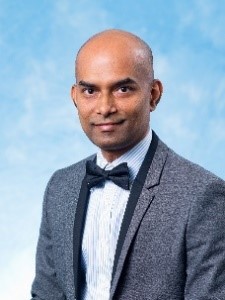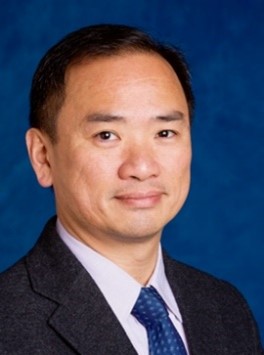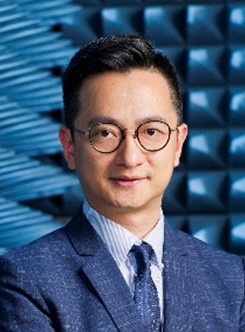主讲人:
1 Roy Vellaisamy (Professor, University of Glasgow)
2 Kin-Fai (Kenneth) Tong (湯建輝) (Professor, IEEE Fellow, University College London)
3 Hang Wong (黃衡) (Deputy Director, State Key Laboratory of Terahertz and Millimeter Waves, City University of Hong Kong)
邀请人:陈哲,助理教授
讲座时间:2023年8月10日10:00-12:00
讲座地点:沧海校区电信学院致信楼N710
报告1:“Research to Realization” - From molecular level interaction to real-time monitoring electronic systems
时间:10:00-10:40
报告人:Roy Vellaisamy, Professor, University of Glasgow
报告摘要:
Growing industrialization and urbanization has put human beings and other living organisms at risk against new threats due to the contamination of food, water and air. These Contaminants endanger all the living organisms in this world, especially for human beings’ genetic disorders. The WHO statistics show that more than 422 million people worldwide are suffering from contamination related illness. The growing prevalence of such disorders has been linked to exposure to chemicals in plastic, food and water. Although regulatory steps have been taken to minimize risk, cases of overexposure still occur. In this talk, I will present our real-time monitoring system for a rapid pre-screening test that could curtail cases of contamination. Over the years, we have developed an electronic sensor platform based on molecular level interaction between the target and analyte to detect various toxins. The advantage of our sensor platform is that it can be used for on-site detection; it is easy to operate and provides results on real-time basis. In addition, we have extended our sensor platform system for healthcare applications such as detection of cancer biomarkers and monitor pulse waveform in real-time. In this talk, I will present our recent accomplishments on intelligent sensing, neuromorphic devices, and next generation communication materials.
报告人简介:

Roy Vellaisamyis a Professor of Intelligent Systems and leader of Molecular Electronics(MOLEC)group and Co-Director of Communication Sensing and Imaging (CSI) group which hosts more than 20 academics and 15 post-doctoral researchers at the University of Glasgow.Prior to Glasgow, he held faculty positions at City University of Hong Kong for 11 years (2008 to 2019; Assistant & Associate Professor) and The University of Hong Kong (2004 to 2008; Research Assistant Professor). He holds adjunct positions at UESTC, Chengdu & SZAR (ShenZhen Academy of Robotics), China.He works on multidisciplinary research blending device physics with materials chemistry and electronic engineering with particular focuses onintelligent devices and systems for sensing application, wearable thermoelectrics, THz materials and neuromorphic devices.He has published over 200 journal articles with h-index 52 (google scholar) and has 21 US/International/Chinese patents. In 2019, he received gold medal for his“Sensor Platform” at the 47thInternational Exhibition of Inventions Geneva.He is also recipient ofTRIL-Research Fellow (2003-04) awarded by The International Centre for Theoretical Physics (ICTP,UNESCOinstitution), Trieste, Italy, Excellent Product Award (2011, 12, 13 & 18) at China Hi-Tech Fair awarded by the PRC's Ministry of Commerce and secured “1000 talent plan” of Zhejiang province (2017). Together with his graduate students, Roy as a founding member, established 3 spin-off companies in HK and Scotland for the development of point of care diagnostic tools. Roy works closely with industries in Greater Bay Region for the development of sensor technologies.
报告2:Be Water My Friend - It may change the future mobile communications
时间:10:40-11:20
报告人:Kin-Fai (Kenneth) Tong (湯建輝), Professor, IEEE Fellow, University College London
报告摘要:
Many people know the famous quote of Bruce Lee: “Empty your mind, be formless, like water”. Such concept has been proven very effective in Martial Art, but can we apply similar concept to our scientific research?
With research efforts gearing up to build the sixth-generation (6G) mobile communications, it is only logical to seek new mobile technologies that can provide the next generational leap for much better performance under harsher environments. To this end, one interesting concept is fluid antenna system (FAS) which utilizes flexible antenna architectures such as liquid-based antennas, reconfigurable RF pixel-based antennas, stepper motor-based antennas, and etc., to enable reconfigurability of antenna’s position (i.e., port). In so doing, tremendous space diversity can be obtained in a novel way. The possibility of accessing seemingly a continuous fading envelope in the spatial domain also means that multiple access can be realized in a simple manner without complex optimization and processing. This is the first of a three-part letter that reviews the basic principles of FAS. Our scope focuses on the physical-layer performance metrics and we discuss the evolution of the channel models being adopted for FAS and summarize the key results highlighting its potential.
In this talk, we will share our experience with you how fluid antenna may replace its solid counterpart and be used in mobile communications. How fluid’s formless feature can solve the problems in modern wireless communications. Although you may not see any board breaking demonstration, hopefully it could inspire you to some new ground-breaking ideas.
报告人简介:

Kin-Fai (Kenneth) Tongis a Professor of Antennas and Applied Electromagnetics and member of the Sensors, Systems and Circuits Group at the Department of Electronic and Electrical Engineering (EEE) in UCL. He has a track record in novel antenna design and microwave/millimetre-wave measurement in different applications such as radar, wireless communications, and medical related applications. During his PhD research, he has been credited to be one of the first who introduced the idea of embedding microstrip patch antennas into mobile phone handsets. He was an Expert Researcher in the Photonic and Millimetre-wave Devices Group of the National Institute of Information and Communications Technology, Japan. Prof. Tong is a Fellow of IEEE, Chartered Engineer of UK Engineering Council, Fellow of Electromagnetic Academy USA and Fellow of Higher Education Academy UK.
报告3:Functional-Material Integrated High-Frequency Devices for Millimeter-wave and Terahertz Applications
时间:11:20-12:00
报告人:Hang Wong (黃衡) (Deputy Director, State Key Laboratory of Terahertz and Millimeter Waves, City University of Hong Kong)
报告摘要:
Technology market forecasts high-frequency products will boost up rapidly in the coming decades not only the popular microwave electronics but also that of unreleased millimeter-wave and terahertz inventions. Scientists put hard efforts to demonstrate both feasibility and capability of the new allocated frequency spectrum by ITU from 110 to 450 GHz that can be commercialization through the introduction of emerging applications of wireless systems such as 6G communications, terahertz imaging, millimeter-wave detection and sensing, low-orbit space communications, intelligent ultra-fast wireless, green energy network, etc. In this talk, the speaker is going to introduce recent high-frequency electronic developments by other world-leading antenna research groups and share state-of-the-art antenna technologies invented at the State Key Laboratory of Terahertz and Millimeter Waves, City University of Hong Kong. Breaking through the bottleneck of PIN diode at high-frequency devices, the speaker will demonstrate some examples of using functional materials to design millimeter-wave and terahertz reconfigurable, tunable, and switchable devices including antennas, metasurfaces, polarizers, modulators, and filters.
报告人简介:

Hang Wongreceived a Ph.D. degree from City University of Hong Kong in 2006. He joined the Department of Electrical Engineering in 2012 and is currently an Associate Professor and the Deputy Director of the State Key Laboratory of Terahertz and Millimeter Waves. He had several visiting professorships at Stanford University, USA; University of Waterloo, Canada; University of College London, UK; and University of Limoges, France in 2011, 2013, 2014, and 2015 respectively. His research interests include designs of wideband antennas, reconfigurable antennas, millimeter-wave antennas, terahertz antennas, functional-material antennas and related applications. He has published over 280 papers, 30 patents, and 2 book chapters, with Google citations of 7000+ and an H-index of 47. He is the chair of the IEEE Antennas and Propagation /Microwave Theory and Techniques (MTT) Chapter of Hong Kong, the IEEE APS Region-10 Representative, the associate editor of IEEE Transactions on Antennas and Propagation (TAP), and the associate editor of IEEE Antenna Wireless Propagation Letters (AWPL). Dr. Wong was the general co-chair of 2020 Asia Pacific Microwave Conference; and the general chair of 2021 Cross Strait Radio Science and Wireless Technology Conference. His contribution has been highly recognized by numerous technical awards and best paper awards at the international conferences at the countries of USA, UK, France, Korea, Japan, and China. He pioneered and was a co-inventor of L-probe dual-polarization antenna technology in 2004, magneto-electric antenna technology in 2006, and the first generation of Beidu’s handheld antennas in 2008, thin-intelligent antenna in 2013, reconfigurable-metal-liquid antenna in 2018, and programmable-terahertz meta in 2020. Parts of his antenna inventions were adopted by industry leaders to satellite navigation system, wireless sensing network, 5G MIMO base-stations, and auto-payment systems for vehicles. He was awarded the top 2% most-cited scientist by Stanford University in 2021 and 2022.

